Scaphoideus titanus最新动态:生物学、生态学和作为病媒的作用
IF 4.6
1区 农林科学
Q1 ENTOMOLOGY
引用次数: 0
摘要
Scaphoideus titanus Ball(半翅目:蝉科)原产于近北极地区,无意中传入欧洲后已成为葡萄生产的主要威胁。Scaphoideus titanus 是影响葡萄的最重要的植物支原体的高效传播媒介。因此,许多欧洲国家都对这种害虫进行了强制杀虫处理。此外,由于其地理分布范围不断扩大,这种叶蝉对一些非欧洲国家构成了严重威胁。在这篇文章中,我们回顾了目前对其分类学、形态学、生物学、生态学及其作为媒介的作用的了解。最后,我们指出了研究工作所面临的主要挑战,这些挑战的目的是减少 S. titanus 和 flavescence dorée 在欧洲的扩展,并避免该疾病在旧大陆以外的地区传播。本文章由计算机程序翻译,如有差异,请以英文原文为准。
Scaphoideus titanus up-to-the-minute: biology, ecology, and role as a vector
Native to the Nearctic region, Scaphoideus titanus Ball (Hemiptera: Cicadellidae) has become a major threat for grapevine production after being unintentionally introduced into Europe, where it became the main vector of flavescence dorée phytoplasma, being mainly associated with the genus Vitis. Scaphoideus titanus is a highly efficient vector of the most important phytoplasma affecting grapevine. For this reason, compulsory insecticide treatments have been introduced against this pest in many European countries. Moreover, the continuous expansion of its geographical distribution makes this leafhopper a serious threat for several non-European Countries. In this article, we review the current knowledge about its taxonomy, morphology, biology, ecology, and its role as a vector. Finally, we point out the main challenges for research aimed at reducing S. titanus and flavescence dorée expansion across Europe and avoiding spread of the disease outside the Old World.
求助全文
通过发布文献求助,成功后即可免费获取论文全文。
去求助
来源期刊

Entomologia Generalis
生物-昆虫学
CiteScore
7.10
自引率
18.80%
发文量
72
审稿时长
>12 weeks
期刊介绍:
Its scope covers all aspects of basic and applied research dealing with insects and more broadly with arthropods inhabiting wild, agricultural and/or urban habitats. The journal also considers research integrating various disciplines and issues within the broad field of entomology and ecology.
Entomologia Generalis publishes high quality research articles on advances in knowledge on the ecology and biology of arthropods, as well as on their importance for key ecosystems services, e.g. as biological control and pollination. The journal devotes special attention to contributions providing significant advances (i) on the fundamental knowledge and on sustainable control strategies of arthropod pests (including of stored products) and vectors of diseases, (ii) on the biology and ecology of beneficial arthropods, (iii) on the spread and impact of invasive pests, and (iv) on potential side effects of pest management methods.
Entomologia Generalis welcomes review articles on significant developments in the field of entomology. These are usually invited by the editorial board, but proposals may be sent to the Editor-in-Chief for preliminary assessment by the editorial board before formal submission to the journal. The journal also considers comments on papers published in Entomologia Generalis, as well as short notes on topics that are of broader interest.
 求助内容:
求助内容: 应助结果提醒方式:
应助结果提醒方式:


